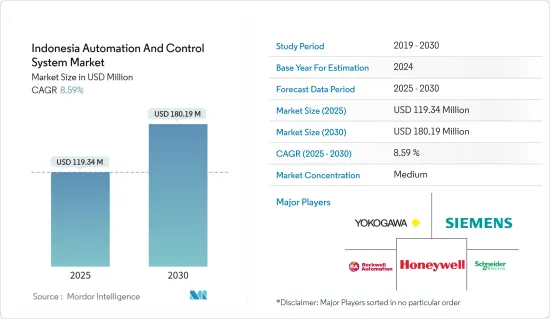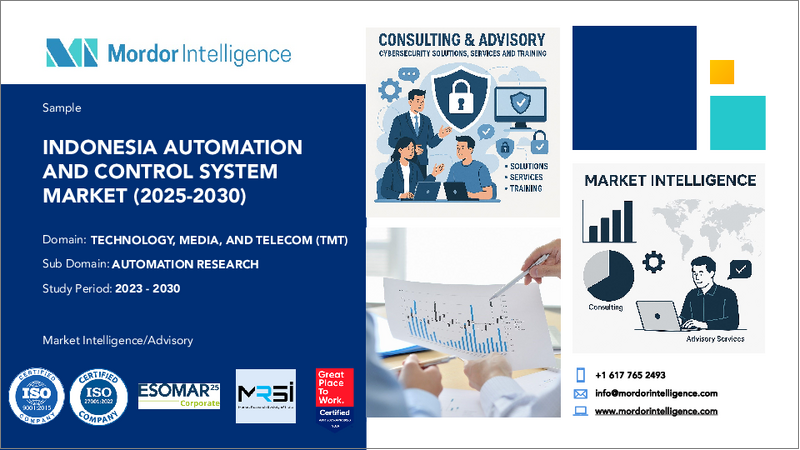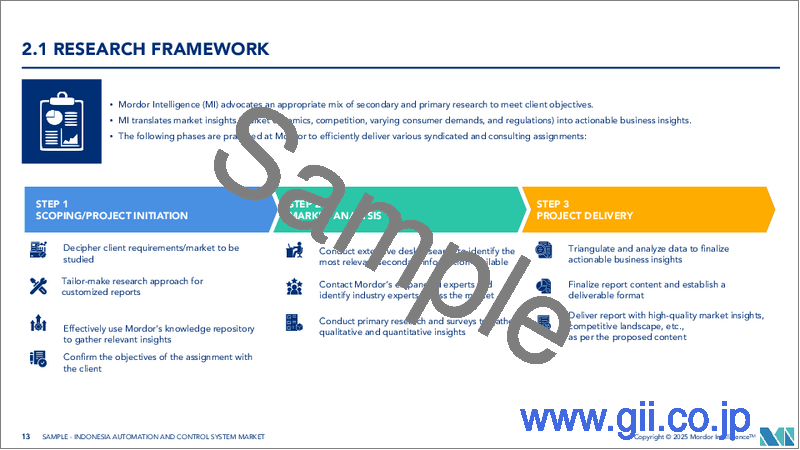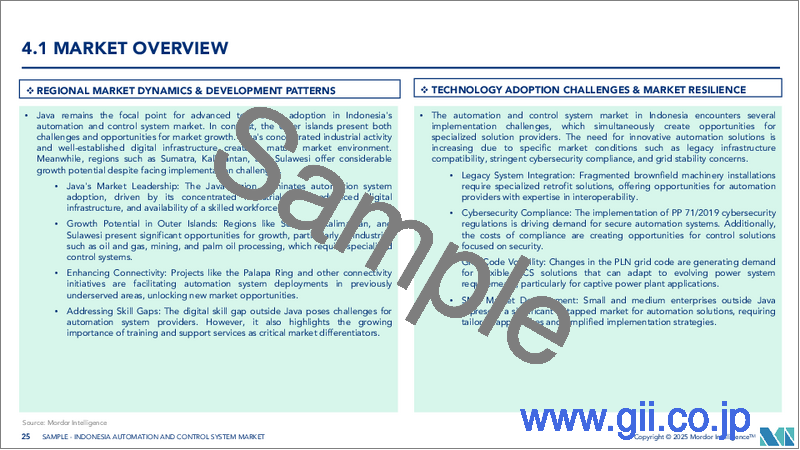|
|
市場調査レポート
商品コード
1642142
インドネシアのオートメーションと制御システム:市場シェア分析、産業動向、成長予測(2025~2030年)Indonesia Automation And Control System - Market Share Analysis, Industry Trends & Statistics, Growth Forecasts (2025 - 2030) |
||||||
カスタマイズ可能
適宜更新あり
|
|||||||
| インドネシアのオートメーションと制御システム:市場シェア分析、産業動向、成長予測(2025~2030年) |
|
出版日: 2025年01月05日
発行: Mordor Intelligence
ページ情報: 英文 100 Pages
納期: 2~3営業日
|
全表示
- 概要
- 目次
インドネシアのオートメーションと制御システム市場規模は2025年に1億1,934万米ドルと推定され、予測期間(2025~2030年)のCAGRは8.59%で、2030年には1億8,019万米ドルに達すると予測されます。

世界経済との融合が着実に進むインドネシアでは、オートメーションと制御システムがコスト削減に不可欠となります。
主要ハイライト
- オートメーションと制御システムとは、商品やサービスの製造・流通に関わる幅広いプロセスを監督・制御するシステムのことです。組立ラインから発電所まで、多くの普遍的で不可欠なサービスは、オートメーションと制御システムに依存しています。たとえば、近代国家の社会的、産業的、経済的福利を維持する公益事業や通信インフラの多くは、オートメーションと制御システムに依存しています。
- インドネシアは、オートメーションを高度に導入している著名な工業メーカーです。製造業は、国のGDPにかなりの額を貢献しています。例えば、インドネシア統計局によると、2022年、インドネシアの製造業は国内総生産(GDP)の18%以上を占め、同国の経済に最も大きく貢献しています。インドネシアとマレーシアの堅調な製造活動は、研究市場の需要を増大させると考えられます。
- 数多くの産業セグメントでオートメーションシステムを奨励する政府資金の増加、さまざまな製造部門からのオートメーションに対する旺盛な需要、産業用ロボットの技術革新の増加、製造業の技術進歩の急増、人口増加に対応するための大量生産と関連サプライチェーンの必要性が、インドネシアのオートメーションとプロセス制御システム市場の成長を促進する重要な要因です。
- インドネシアの鉱物資源は広大で未開拓であり、スズ、パーム油、一般炭の世界最大の輸出国です。また、ニッケル、銅、ボーキサイト、ゴム、マンガン、亜鉛、鉛などの主要輸出国のひとつでもあります。鉱業はインドネシアのGDPの約10分の1を占め、長年にわたり同国の経済発展に重要な役割を果たしてきました。金属や鉱物の需要の高まりは、半導体やエレクトロニクスの需要の増加とともに、鉱業部門におけるオートメーションシステムの採用を後押ししています。
- エネルギー部門では、スマートシティプログラムの出現により、オートメーションと制御システムの需要が増加しています。インドネシアは、都市化の課題に対処することを目的とした包括的なデジタル化プログラムである「100のスマートシティ運動」を立ち上げ、この点で主導的な役割を担っています。このイニシアチブは、都市化の問題に取り組む政府計画の一環で、2045年までにインドネシア人口の83%が都市部に居住するようになるという予測が示されています。
- インドネシアはまた、革新的なバイオマス混焼プログラムを通じて、既存の蒸気発電所の緑化を改善するためにバイオマスの利用を奨励しています。このプログラムでは、2025年までに52カ所でバイオマスを混焼することを目標としており、すでに37カ所でバイオマスを混焼し、2023年までに108万トンの目標を達成するために30万6,000トンを使用しています。このようなプログラムや、同国の電力・公益事業部門を発展させるための新たなプロジェクトや投資は、同国におけるオートメーションと制御システム導入の新たな市場機会を生み出すと期待されています。
- しかし、オートメーションと制御システムに関連する初期コストは高いです。カスタマイズと統合の複雑さが、全体的なコストに拍車をかけています。さらに、オートメーション機器の導入には、工場の既存のインフラに変更を加える必要がある場合があります。これには、新しい機器に対応するためのレイアウト、電気システム、安全機能の変更が含まれる場合があり、追加コストが発生します。こうした要因が市場成長の妨げになる可能性があります。
インドネシアのオートメーションと制御システム市場動向
飲食品がインドネシアのオートメーションと制御システム市場を牽引
- 飲食品部門はインドネシア経済において重要な位置を占めており、国のGDPに欠かせない貢献者としての役割を果たしています。同産業は豊富な天然資源と拡大する内需から恩恵を受け、その回復力を強化しています。特に、2022年第2四半期において、飲食品セクターは非石油・ガス産業のGDPの38.38%を占め、インドネシア国内におけるGDP貢献の面で主要なサブセクターとしての地位を確固たるものにしています。
- インドネシア統計局(BPS)のデータによると、飲食品(F&B)産業は2022年に年間ベースで4.90%増加し、8,130億6,200万IDRとなりました。この状況は、飲食品そのもの生産量の増加と不可分です。CRIFの2023年の予測によると、飲食品産業は前年比約5%の増加が見込まれています。この成長に影響を与える要因として、経済環境の変化に対する飲食品産業の感度の高さが挙げられます。CRIFはまた、特にCOVID-19パンデミック後の国家経済回復の状況において、この産業は依然として良好な展望を持っていると考えています。
- 2030年までにインドネシアを世界の上位10経済圏に位置づけることを目指す「Making Indonesia 4.0」戦略では、モノのインターネット(IoT)、オートメーション、ロボット工学、人工知能、センサ技術などの重要技術をその中核的な要素として位置づけています。この戦略における優先セグメントの中でも、飲食品産業は際立っています。その結果、国内の飲食品部門はデジタル変革への需要が高まり、オートメーションと制御システムの増加につながると予想されます。国のインダストリー4.0産業戦略に沿って、インドネシア政府は地元の飲食品産業に対し、デジタルの進歩を受け入れ、製造に地元の原料を使用する方向へ移行するよう促しています。
- 食品の安全性は飲食品産業にとって極めて重要な要素であり、COVID-19はその重要性をさらに高めています。メーカーは食品安全対策を精査し、強化する必要に迫られています。ロボットの導入は、人の介在を不要にすることで食品の安全性を向上させるのに役立ち、それによって食品製造施設における二次汚染のリスクを大幅に低減することができます。さらに、インドネシアを含め、包装食品の需要は世界的に急増しており、食品包装施設では手作業に代わって先進的機械が導入されています。
- さらに、インドネシア統計局のデータによると、同国はZ世代とミレニアル世代の消費者が52%を占めており、彼らに対応するため、企業はデジタル進化の面で追いつくべく進化・努力しており、オートメーションと産業制御技術の需要にプラスの影響を与えています。飲食品(F&B)製造業は、生産と品質を向上させるため、IIoT、AI、PLC、ロボットなどのツールを取り入れています。リアルタイムデータ処理と予測分析の開発は、効果的な意思決定のため洞察を生み出すデータ活用の新しい方法の導入にさらに貢献しています。
DCSがインドネシアのオートメーションと制御システム市場で優位な地位を占める
- 分散型制御システム(DCS)は、局所的なプロセスの複雑さを管理する複数の統合サブシステムを監督する監督レベルの制御を含む統合制御アーキテクチャです。DCSは主に石油・ガス精製、石油生産などの工業プロセスで利用されています。これらのシステムは、制御の信頼性と性能を高めるために、冗長性と診断機能を備えた特別な設計となっています。分散されたディスクリートフィールドデバイスとその操作ステーションを制御する柔軟性を高めています。
- 分散制御システム(DCS)の拡大性は重要な利点です。包括的な統合システムとして初期導入することも、必要に応じて拡大できるスタンドアロンシステムとして導入することもできます。市場成長にプラスの影響を与えると予想されるのは、電力エネルギーセグメントの需要拡大や国内の産業インフラ開拓などです。
- DCS Systemsは、分散コントローラ、ワークステーション、その他のコンピューティング要素間のピアツーピアアクセスなど、大きな利点を記載しています。石油化学、原子力、石油・ガスなどのプロセス産業では、精密な制御とセットポイント周辺のプロセス許容度を提供するコントローラへの需要が高まっています。インドネシアの石油・ガスセクターでは投資が増加しており、DCS用途の新たな機会が生まれています。DCSは石油・ガス産業で広く使用されており、生産プロセスの制御を強化します。
- インドネシアは世界的に著名な天然ガス生産国であり、アジア太平洋ではオーストラリア、中国に次いで3番目に大きなガス埋蔵量を有しています。同国は、エネルギー生産と探査を強化するため、南シナ海のブロックを含む10の石油・ガス鉱区の割り当てを提案しています。2022年には13の石油・ガス田が競売にかけられました。さらに、SKK Migasは、近隣にあるエニの既存ガス生産施設を組み込んだ開発計画の見直しを条件に、ゲンダロ・ゲヘムプロジェクトが2022年までに8億4,400万cfdのピークガス生産量に達し、2027年に生産が開始されると予測しています。産業におけるこうした大きな進歩は、このセグメントでのDCS機器の採用を促進すると考えられます。
- また、同地域の水道産業におけるDCSの採用、投資、デジタル化の高まりにより、同市場は大きな需要が見込まれます。PDAMとして知られるインドネシアの地元水道会社は、デジタル技術を取り入れることで業務とサービスを近代化するプロセスに着手しています。顧客検針、デジタル請求、苦情管理、従業員データベース、給与計算などの用途の統合に成功し、より迅速で効率的な管理プロセスを実現しています。
- 2023年、Perumdam Tirta SanjiwaniとBima Sakti Alterraは、包括的なSWGMソリューションの導入に合意し、Blahbatuh技術ゾーンで検査的に導入されました。この開発は、水処理業務の効率性、信頼性、安全性を高めると同時に、運用コストと環境への影響を削減するものであり、DCSの普及に向けた積極的な一歩と見ることができます。
インドネシアのオートメーション制御システム市場の競合情勢
インドネシアのオートメーションと制御システム市場は、中程度の競争状態にあり、複数の大手企業で構成されています。市場シェアの面では、現在数社の大手企業が市場を独占しています。顕著な市場シェアを持つこれらの主要企業は、多数の国にわたって顧客基盤の拡大に注力しています。
2022年5月、ETAPとSchneider Electricは、EcoStruxure Power OperationとETAP Operator Training Simulator(eOTS)とETAP Power System Monitoring &Simulation(PSMS)の統合を発表しました。この特別な統合により、すべてのEcoStruxure Power OperationシステムがETAPデジタルツインに継続的に接続されます。
2022年4月、Rockwell Automationは、シンガポールを拠点とするインダストリー4.0技術プロバイダーであるCAD-ITとの最新の提携により、パートナーネットワークを強化しました。CAD-ITは東南アジアに広大なネットワークを持ち、インドネシアを含む複数の国に進出しています。今回の提携により、CAD-ITはRockwell Automationのスマートマニュファクチャリングソリューションやオートメーションソリューションなどを提供することになります。
その他の特典
- エクセル形式の市場予測(ME)シート
- 3ヶ月間のアナリストサポート
目次
第1章 イントロダクション
- 調査の前提条件と市場定義
- 調査範囲
第2章 調査手法
第3章 エグゼクティブサマリー
第4章 市場洞察
- 市場概要
- 産業の魅力-ポーターのファイブフォース分析
- 供給企業の交渉力
- 買い手の交渉力
- 新規参入業者の脅威
- 代替品の脅威
- 競争企業間の敵対関係の強さ
- COVID-19の産業への影響評価
第5章 市場力学
- 市場促進要因
- インドネシアの電力セクターの繁栄と発電能力の向上
- インドネシアにおける無線プロトコルと無線センサネットワーク技術の進化と開発
- 産業開発と能力増強のための投資
- 市場抑制要因
- 高額な設備投資
- 変動する商品価格と不安定な経済シナリオ
第6章 市場セグメンテーション
- 製品
- プログラマブルロジックコントローラ
- モニタリング制御とデータ収集
- 分散制御システム
- ヒューマンマシンインターフェース
- 安全システム
- 産業用ロボット
- 電気モーター(AC、DC、EC、サーボ、ステッピングモーターを含む)
- ドライブ(AC、DC、サーボを含む)
- エンドユーザー産業
- 石油・ガス
- 電力
- 化学・石油化学
- 飲食品
- 金属・鉱業
- 上下水道
- その他
第7章 競合情勢
- 企業プロファイル
- Yokogawa Corporation
- Siemens AG
- Honeywell International Inc.
- Rockwell Automation Inc.
- Schneider Electric Co.
- ABB Ltd.
- Emerson Electric Co.
- PT FANUC Indonesia
第8章 電動モーターと産業用ロボットの輸入分析
第9章 投資分析
第10章 投資分析市場の将来
The Indonesia Automation And Control System Market size is estimated at USD 119.34 million in 2025, and is expected to reach USD 180.19 million by 2030, at a CAGR of 8.59% during the forecast period (2025-2030).

With Indonesia's steady amalgamation with the world's economy, Indonesia's Automation and Control System will be essential in bringing costs down.
Key Highlights
- Automation and Control System refers to systems that oversee and control a wide range of processes involved in manufacturing and distributing goods and services. Many universal and essential services depend on Automation and Control Systems, from assembly lines to power stations. For example, many utility or telecommunication infrastructures that maintain a modern nation's social, industrial, and economic well-being rely on Automation and Control Systems.
- Indonesia is a prominent industrial manufacturer that highly adopts automation in its industries. Manufacturing contributes a considerable amount to a country's GDP. For instance, according to Statistics Indonesia, in 2022, Indonesia's manufacturing sector contributed over 18 percent of the country's GDP, the most significant contributor to the nation's economy. The robust manufacturing activities in Indonesia and Malaysia will likely augment the demand for the studied market.
- Growing government funding to encourage automated systems in numerous industrial verticals, booming demand for automation from different manufacturing sectors, increasing innovations in industrial robotics, swelling technological advancements in manufacturing, and the need for mass production and related supply chains to cater to the rising population are the crucial factors driving the growth of automation and process control systems market in Indonesia.
- Indonesia's mineral resources are vast and unexplored, and it is the world's largest exporter of Tin, palm oil, and thermal coal. It is also one of the major exporters of Nickel, Copper, Bauxite, Rubber, Manganese, Zinc, and Lead, among others. Mining accounts for about a tenth of Indonesia's GDP and has played a vital role in the country's economic development over the years. The rising demand for metals and minerals, with the growing demand for semiconductors and electronics, fuels the adoption of automated systems in the mining sector.
- The energy sector is experiencing an increase in demand for automation and control systems due to the emergence of smart city programs. Indonesia has taken the lead in this regard by launching the 100 Smart Cities Movement, a comprehensive digitalization program aimed at addressing urbanization challenges. This initiative is part of the government's plan to tackle the issue of urbanization, with projections indicating that 83 percent of the Indonesian population will reside in urban areas by 2045.
- Indonesia is also encouraging the use of biomass to improve the greening of existing Steam Power Plants through the innovative Biomass Co-Firing program. The program aims to co-fire biomass in 52 locations by 2025 and has already co-fired biomass in 37 areas, using 306 thousand tons to reach the 1.08 million ton target by 2023. Such programs and new projects and investments to develop the power and utility sector of the country are expected to create new market opportunities for the implementation of automation and control systems in the country.
- However, the initial costs associated with automation and control systems are high. The complexity of customization and integration adds to the overall costs. Moreover, installing automation equipment may require modifications to the existing infrastructure of the factory. This can include changes to the layout, electrical systems, and safety features to accommodate new equipment, which incur additional costs. Such factors might hinder the market growth.
Indonesia Automation and Control System Market Trends
Food and Beverages to Drive the Indonesia Automation and Control System Market
- The food and beverage sector holds a prominent position in Indonesia's economy, serving as a vital contributor to the nation's GDP. The industry benefits from abundant natural resources and a growing domestic demand, bolstering its resilience. Notably, during the second quarter of 2022, the food and beverage sector accounted for a substantial 38.38 percent of the non-oil and gas industry's GDP, solidifying its status as the leading sub-sector in terms of GDP contribution within Indonesia.
- Based on data from Statistics Indonesia (BPS), the food and beverage (F&B) industry increased by 4.90 percent on an annual basis in 2022 to IDR 813.062 billion. This condition is inseparable from the increased production of the food and beverage commodity itself. According to CRIF forecasts for 2023, the food and beverage industry is expected to experience an increase of around 5 percent compared to the previous year. Factors influencing this growth are the high sensitivity of the food and beverage industry to changes in the economic environment. CRIF also considers that this industry still has good prospects, especially in the context of national economic recovery after the COVID-19 pandemic.
- The Making Indonesia 4.0 strategy, which aims to position Indonesia as a global Top 10 economy by 2030, has identified critical technologies such as the Internet of Things (IoT), automation, robotics, artificial intelligence, and Sensor technology as its core components. Among the priority sectors in this strategy, the food and beverage industry stands out. Consequently, the country's food and beverage sector is expected to experience a growing demand for digital transformation, leading to an increase in automation and control systems. In line with the national Making Industry 4.0 industrial strategy, the Indonesian government is urging the local food and beverage industry to embrace digital advancements and transition towards using local raw ingredients for manufacturing.
- Food safety is a crucial element in the food and beverage industry, with COVID-19 further intensifying its significance. Manufacturers have been compelled to scrutinize and enhance their food safety measures. The deployment of robots can aid in improving food safety by eliminating the need for human intervention, thereby significantly reducing the risk of cross-contamination in food manufacturing facilities. Additionally, the demand for packaged food is surging globally, including in Indonesia, where sophisticated machines in food packaging facilities have replaced manual methods.
- Moreover, As per the data from the Indonesia Bureau of Statistics, the country comprises 52 percent of Gen Z and millennial consumers, and in order to deal with them, companies are evolving and working towards catching up in terms of digital evolutions, thus positively impacting the demand for automation and industrial control equipment and technologies. Food & Beverage (F&B) manufacturing has embraced IIoT, AI, PLC, Robotics, and more such tools to move up production and quality. Developments in real-time data processing and predictive analytics further help introduce new ways of utilizing data to generate insights for effective decision-making.
DCS Holds a Dominant Position in Indonesia Automation and Control System Market
- A Distributed Control System (DCS) is an integrated control architecture that includes a supervisory level of control overseeing multiple integrated sub-systems responsible for managing the intricacies of a localized process. DCS is primarily utilized in industrial processes such as oil and gas refineries, oil production, etc. These systems are specifically designed with redundancy and diagnostic capabilities to enhance control reliability and performance. They offer increased flexibility in controlling distributed discrete field devices and their operating stations.
- The scalability of a Distributed Control System (DCS) is a significant advantage. It can be initially implemented as a comprehensive, integrated system or as a standalone system that can be expanded as required. Anticipated positive influences on market growth include the growing demand in the power and energy sectors and the development of industrial infrastructure in the country.
- DCS systems offer significant benefits, including peer-to-peer access between distributed controllers, workstations, and other computing elements. In process industries such as petrochemical, nuclear, and oil and gas, there is a growing demand for controllers that provide precise control and process tolerance around a set point. The Indonesian oil and gas sector's increasing investments are creating new opportunities for DCS applications. DCS is widely used in the oil and gas industry and provides enhanced control over the production process.
- Indonesia is a prominent natural gas producer globally, possessing the third-largest gas reserves in the Asia Pacific region, following Australia and China. The nation has proposed the allocation of ten oil and gas working areas, including a block in the South China Sea, to enhance energy production and exploration. In 2022, 13 oil and gas fields were auctioned. Additionally, SKK Migas has projected that the Gendalo-Gehem project will reach a peak gas output of 844 million cfd by 2022, with production commencing in 2027, subject to a revised development plan that incorporates Eni's existing gas production facilities nearby. These significant advancements in the industry will promote the adoption of DCS devices in the sector.
- The market is also expected to witness a significant demand owing to the rising adoption of DCS, investments, and digitization in the region's water industry. Indonesia's local water companies, known as PDAMs, have embarked on a process of modernizing their operations and services by incorporating digital technology. They have successfully integrated applications for customer meter reading, digital billing, complaint management, employee databases, and payroll, resulting in faster and more efficient administrative processes.
- In 2023, Perumdam Tirta Sanjiwani and Bima Sakti Alterra agreed to implement a comprehensive SWGM solution, which was piloted in the Blahbatuh technical zone. This development can be seen as a positive step towards the widespread adoption of DCS, as it enhances the efficiency, reliability, and safety of water treatment operations while also reducing operational costs and environmental impacts.
Indonesia Automation and Control System Market Competitive Landscape
The Indonesian automation and control system market is moderately competitive and consists of several major players. In terms of market share, few major players currently dominate the market. These major players with a prominent market share are focusing on expanding their customer base across numerous countries.
In May 2022, ETAP and Schneider Electric announced the integration of EcoStruxure Power Operation with ETAP Operator Training Simulator (eOTS) and ETAP Power System Monitoring & Simulation (PSMS), enabling model-driven power system training and predictive analysis for operators and engineers. This specific integration ensures that all EcoStruxure Power Operation systems are connected to the ETAP Electrically Digital Twin continuously on a genuine time basis.
In April 2022, Rockwell Automation strengthened its partner network with its latest partnership with CAD-IT, a Singapore-based Industry 4.0 technologies provider. CAD-IT has a vast network in Southeast Asia, with a presence in multiple countries, including Indonesia. Through the partnership, CAD-IT will offer Rockwell Automation's smart manufacturing and automation solutions, among other solutions.
Additional Benefits:
- The market estimate (ME) sheet in Excel format
- 3 months of analyst support
TABLE OF CONTENTS
1 INTRODUCTION
- 1.1 Study Assumptions and Market Definition
- 1.2 Scope of the Study
2 RESEARCH METHODOLOGY
3 EXECUTIVE SUMMARY
4 MARKET INSIGHTS
- 4.1 Market Overview
- 4.2 Industry Attractiveness - Porter's Five Forces Analysis
- 4.2.1 Bargaining Power of Suppliers
- 4.2.2 Bargaining Power of Buyers
- 4.2.3 Threat of New Entrants
- 4.2.4 Threat of Substitute Products
- 4.2.5 Intensity of Competitive Rivalry
- 4.3 Assessment of the impact of COVID-19 on the industry
5 MARKET DYNAMICS
- 5.1 Market Drivers
- 5.1.1 Flourishing Power Sector and Increased Power Generation Capacities in Indonesia
- 5.1.2 Evolution and Development of Wireless Protocols and Wireless Sensor Network Technology in Indonesia
- 5.1.3 Development of Industries and Investments to Increase Capacities
- 5.2 Market Restraints
- 5.2.1 High Capital Investments
- 5.2.2 Fluctuating Commodity Prices and Volatile Economic Scenario
6 MARKET SEGMENTATION
- 6.1 Product
- 6.1.1 Programmable Logic Controller
- 6.1.2 Supervisory Control and Data Acquisition
- 6.1.3 Distributed Control System
- 6.1.4 Human Machine Interface
- 6.1.5 Safety Systems
- 6.1.6 Industrial Robotics
- 6.1.7 Electric Motors (includes AC, DC, EC, Servo and Stepper Motors)
- 6.1.8 Drives (includes AC,DC and Servo)
- 6.2 End-User Industry
- 6.2.1 Oil & Gas
- 6.2.2 Power
- 6.2.3 Chemical & Petrochemical
- 6.2.4 Food & Beverage
- 6.2.5 Metals & Mining
- 6.2.6 Water and Wastewater
- 6.2.7 Other End-User Industries
7 COMPETITIVE LANDSCAPE
- 7.1 Company Profiles
- 7.1.1 Yokogawa Corporation
- 7.1.2 Siemens AG
- 7.1.3 Honeywell International Inc.
- 7.1.4 Rockwell Automation Inc.
- 7.1.5 Schneider Electric Co.
- 7.1.6 ABB Ltd.
- 7.1.7 Emerson Electric Co.
- 7.1.8 PT FANUC Indonesia





